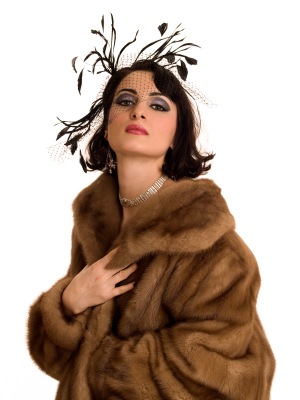Russian Fur Coats
Written by Vadim on May 1, 2009 – 12:00 am -Due to the extremely Cold Winter climate in Russia, especially in the Siberia region in the North, fur coats and other clothing have become a mainstay of life in Russia. Their association with Russia is strongly ingrained in popular culture – movies and television programs depicting Russia or Russian characters, often feature beautiful Russian woman adorned in fur coats, or wearing fur hats.
This article discusses the history and importance of fur, and the qualities of Mink and Sable fur – used to make the finest quality fur coats and jackets.
A Brief History of the Fur Trade in Russia
Before the colonization of the Americas, Russia was a major supplier of fur-pelts to Western Europe and parts of Asia. Fur was a major Russian export as trade developed in the early Middle Ages, first through the Baltic and Black Seas. With the development of railways, Russia traded through the European city of Leipzig (Germany).
Originally, Russia exported a majority in raw furs of the pelts of martens, beavers, wolves, foxes, squirrels and hares. Between the 16th and 18th centuries, Russians tamed Siberia, a region rich in many mammal species, such as Arctic fox, lynx, sable, sea otter and stoat (ermine). In the search for the prized sea otter (pelts first used in China), and, later the northern fur seal, the Russian Empire expanded into North America, notably Alaska. Between the 17th and second half of the 19th century, Russia was the largest supplier of fur in the world. The fur trade played a vital role in the development of Siberia, the Russian Far East and the Russian colonization of the Americas. To this day sable is a regional symbol of Ural Sverdlovsk oblast and Siberian Novosibirsk, Tyumen and Irkutsk oblasts of Russia.
Mink Fur and its Qualities
Because mink fur makes the flattest coat, a mink coat or mink jacket is most flattering fur on the female figure. Less bulk is generally interpreted as more feminine, and is considered more comfortable.
Minks come in a variety of colors, ranging from black, to dark brown (mahogany), medium brown minks ( lunarine), and light brown minks (demi-buff).
Mink coats and mink jackets make very light, soft, flat, and supple clothing. Minks can form a regular part of a wardrobes – mink coats can be worn with everything from jeans to gowns. Mink jackets and mink coats are considered to be able to conform to call kinds of lifestyles. For a coat that will go with literally everything, choose a basic black mink coat.
An important thing to note when purchasing a mink coat is the difference between male and female skins. Male mink skins are large than that of females, so the equivalent patterns can be manufactured using fewer skins, if male skins are being used. Female skins are flatter, silkier, softer, and have a shorter nape, so the thickness of the leather is thinner.
An average female mink coat has approximately forty-five to fifty skins, and an average male mink coat has approximately thirty-six to thirty-nine skins.
Minks hold value longer than any other fur coat, mostly because they are a substantial item. Minks have held value for over twenty-five years. Mink fur can be used in other fur coats, such as leather or shearling coats. Mink fur is known for it’s versatility.
Mink coat care is similar to other methods of fur coat care – store your mink coat in April or May with a professional furrier, and in November, remove it from storage. The storage facility should be between 48-50 degrees, with a similar humidity level. Mink fur care and cleaning should be done seasonally, or if the mink coat gets rained on or spilled on during the winter.
Sable Fur and its Qualities
The sable is an animal that is part of the weasel family, native to Europe, Asian and America. The term ‘Russian fur’ commonly refers to sable fur. A sable coat is traditionally made up of soft wool topped by a dense coat of fur, and then topped again by an even longer coat of hair. Its warmth and practicality makes sable coats indispensable.
A sable coat is one of the most coveted types of fur coat in the fur industry. Sable comes from Russia and is typically extremely expensive. There are Canadian and American made sable fur coats, but Russian sable fur coats are more expensive than their North American counterparts, due to a tighter supply of sable skin. The most valuable sables are Siberian fur and Russian fur.
Sable fur coats are known for their silkiness and their rarity. Russian fur is generally rare, well made, and widely prized. Russian sable fur coats in particular are known for their silky quality and light weight, but will still keep you warm. Authentic Russian sable fur coats are seen as a symbol of status due to their rarity.
References:
http://en.wikipedia.org/wiki/Fur_trade
http://www.furcoats.info/
http://en.wikipedia.org/wiki/History_of_Siberia
Tags: fashion, fur, fur coat, mink, sable
Posted in General | No Comments »





You must be logged in to post a comment.